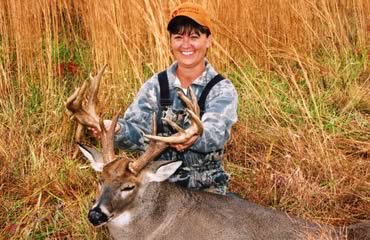Self-confessed deer hunting addict finally gets the trophy of her dreams.
I am the oldest of five girls reared in the country and taught by our father to shoot at an early age. My husband, Joe, has been deer hunting since the first legal Kentucky deer season in 1968. He took our two kids and me with him in 1985, and I’ve been hopelessly addicted to deer hunting ever since.
After the first couple of years, I “graduated” from what Joe called Deer Hunting 101. From then on, I’ve hunted alone. I’ve shot many deer and even a black bear, but I had been wondering if my trophy spot on the wall was ever going to be filled.
The night before gun season on Nov. 12, 2005, we sat at the kitchen table and assigned priority numbers to our top three stands. All of these, we agreed, were capable of producing a trophy buck. On opening day, I spent the morning and afternoon fighting to stay in the Number 1 ladder stand in a 20-mph south wind. After seeing nothing, I opted to go 3 miles away to stand Number 2 for the Sunday afternoon hunt. It was a Texas tower with a roof and windows that would stop the bite of the wind. Joe dropped me off at 2:30 and then drove to a shooting house in another field about 400 yards away.
Stand Number 2 is in the middle of a CRP field with a bedding area cutover on the west side, woods on the east and sloping fields on the north and south. A misty rain started to fall, and it became dead calm. Air currents seemed to be moving straight down.
At 3:30 p.m., deer began to come out of the woods to the east. The first was a buck with both antlers broken off close to the bases. The second was a small 4-pointer heading north, chasing a doe. Things were looking good, but I wanted a buck bigger than the 8-pointer already on my wall.
It was getting late and, with the clouds, it was going to get dark early. I made sure that my scope was turned down to 4-power to gather all the light possible. I looked over my left shoulder to the north field and saw a buck step out of the cutover bedding area and head toward where the 4-pointer and the doe had gone.
 “What a big body,” I thought as I trained my scope on the buck to check its headgear. When the buck came into focus, the first thing I saw was a huge drop tine. Oh boy!
“What a big body,” I thought as I trained my scope on the buck to check its headgear. When the buck came into focus, the first thing I saw was a huge drop tine. Oh boy!
Time was running out, and the buck was walking fast. As I lined up on its shoulder, I concentrated only on the shot. I wanted to stop the deer, but my first mouth bleat had no effect. I quickly tried again, much louder. The buck stopped, quartering toward me.
“Squeeze it like a lemon, hold on point of shoulder,” I silently instructed myself. At the recoil, the deer turned and ran. As I chambered another round, it disappeared over a hill.
I shakily called Joe on my radio and told him to come quickly. He was concerned and told me to sit down and to breathe. He got me out of the stand, and we tracked the buck, finding him on his back with head and rack hidden in the tall fescue of the CRP field.
Joe said, “Okay, he’s dead. Roll him over and let’s see his head.” When I did, we were both astounded. I had to sit down for a minute as Joe explained to me that I’d taken a dream deer — a 16-pointer that field-dressed at 208 pounds.
Editor’s note: Linda’s buck was scored for the BTR and measured an impressive 175 3/8 composite inches.
Read Recent Articles: • No Respect: Why Indiana is the Midwest’s most overlooked hotspot.
• Big Woods Bucks: Whitetails in large timber tracts are harder to pattern, but it’s not impossible.
• Arrow Spine Rules: How this little understood arrow factor can make or break your setup.
This article was published in the September 2008 edition of Buckmasters Whitetail Magazine. Join today to have Buckmasters delivered to your home.